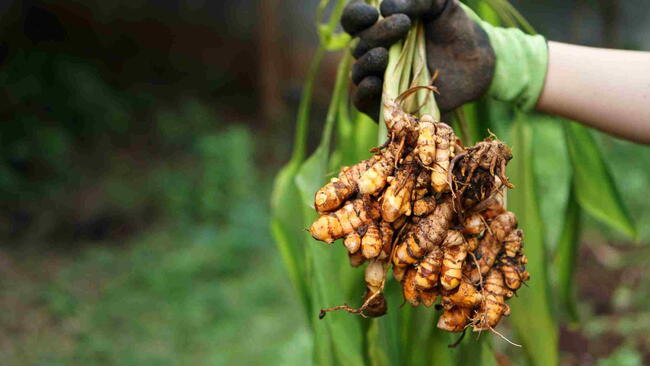
Photo Credit
Bigc/Shutterstock
Subhead
Grow your own flavorful ginger with this simple guide to planting, caring for, and harvesting ginger root—indoors or out.
Read Next
Gardening Products
Cooking Notes
- Ginger is a common cooking spice, used in teas, ginger ale, ginger cider, gingerbread, and ginger snaps. It’s also a medicinal ingredient found in capsules, oils, extracts, and tinctures.
- Fresh ginger may be grated, sliced, or minced, as well as crystallized, candied, and pickled. Powdered dried ginger is the form most often used in baking.
- Recipes calling for a knob of ginger typically mean a 2-inch piece, whereas a thumb of ginger generally means a 1-inch piece.
- When peeling ginger, use a spoon—not a knife—to scrape off the outer skin.
- Add ginger in the beginning of the cooking process for a more subtle flavor or near the end for a fuller, more pungent flavor.
Pickle fresh ginger by slicing peeled fresh ginger into thin slices (using a vegetable peeler) and placing in a container with equal parts vinegar and sugar (or, to taste). Store in the fridge for up to 2 months.
More Like This
Never grew ginger before, but i like that spicy stuff....
Before did grow curcuma (tumeric) is not difficult and until time to harvest it looks impressing
You can store ginger pretty much forever by peeling and submerging it in vodka. (I broke it into a usable size, not too big, not too small.) It is always at the ready and...the vodka can be added to your ginger ale for a little kick!
The alcohol is removed in the cooking process.
Excellent tip! Thanks!
I adore YOU! Thank you for all that you do to teach & share with us. I bought organic ginger at Costco, so I have many roots. I live NW of Austin TX am excited to start growing my ginger and the tip of freezing prior to shredding is fantastic. Thank you again!
I’ve grown ginger for several years in large plastic pots on the northern side of Atlanta Georgia. I always wear gloves because I have sensitive skin. One day, I wasn’t wearing gloves and plucked a couple of weeds out of that ginger pot. Soon afterwards, my skin started to burn and was very painful. I didn’t know what was causing this. I searched online and found the answer. I had brushed the leaves with my bare hand. The ginger leaves have a substance that’s a protects against predators. So, now I never work around the ginger pot without gloves!!
This is my second year growing ginger and I love it! I grow mine in huge pots outdoors under some roma tomato plants in direct sunlight. Next year I may move them to the tubs in a more shaded area of the garden. Thanks for the tips and tricks, now I know better. Love the videos! Keep up the great work.
Why can’t I save these articles on ginger to Pinterest?
Unfortunately, we had to block using Pinterest on our site because they were breaking our web pages. Hopefully, they will find a fix for this in the future and we will be able to reinstate saving articles to Pinterest. Apologies for the inconvenience. - Almanac.com Technical Support
Your first photo is turmeric and the second one is galangal. Good job..SMH
both Ginger (Zingiber officinale) Turmeric and Galangal are in the Ginger family;










Comments